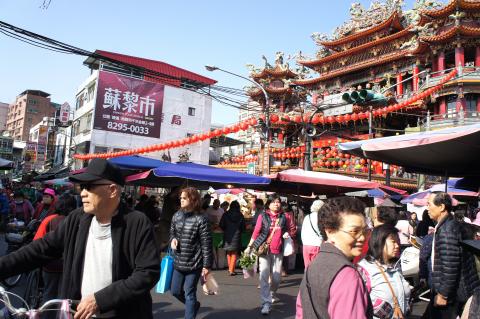Yonglian, Baohe and Dazhong temples are all located in the vicinity of the area officially known as “Lujhou temple entry commercial community” in New Taipei City’s Lujhou District, which at night transforms into a bustling night market. The nominal commercial district, however, lacks the unique characteristics that would typically draw in tourists. The New Taipei City Government will be guiding local industries this year in using Lujhou’s shenjiang (heavenly generals) culture to develop creative products, hopefully putting the area on par with the market area surrounding Senso-ji — a temple in Japan dedicated to Kannon (Avalokitesvara) — and turning the commercial district into a New Taipei City landmark.
New Taipei City Economic Development Department Deputy Director-General Huang Cheng-cheng says that the Lujhou commercial district near the temples is concentrated at the intersection of Chenggong Rd and Desheng St and neighbors Sanmin Senior High School MRT Station, giving the area strong development potential. Last year the local government assisted the Lujhou District Commercial District Prosperity Association in applying for local industry development funding from the Ministry of Economic Affairs. An educational program will be set up to help innovate traditional industries by infusing them with shenjiang imagery, introducing creative and design concepts, and offering classes on related subjects.
Huang Chin-fu, president of the association, says that since the MRT Luzhou (Lujhou) Line opened it has definitely brought more visitors to the commercial district surrounding the temples. It is a pity that the number of return visits, however, is kept so low because the area has nothing locally that would attract tourists from other areas, Huang says. He also hopes that the century-long history of local shenjiang culture can be used to create a distinguishable imagery and even become part of a cultural symbolism that belongs uniquely to New Taipei City.

Photo: Lai Hsiao-tung, Liberty Times
照片:自由時報記者賴筱桐
Huang says that the project, which includes collaborating with local companies to develop shenjiang creative products and souvenirs, is expected to commence next month. Special areas will also be set up to display and sell agricultural products from New Taipei City, which will provide job opportunities to disadvantaged people who will serve as vendors, Huang says. Between 80 and 100 temple lanterns will be hung outside of local shops to give the commercial district a more historic atmosphere, Huang says, adding that the market area around Japan’s Senso-ji will serve as their primary object of study in trying to attract more tourists.
The bureau says that the “Lujhou District shenjiang cultural industries development project” is a three-year project that aims to combine shenjiang imagery with local life, consolidate local industries, help businesses combine their networking resources and reach consensus on various issues. In the process, strengthening local industries and stimulating consumer spending should help the commercial district become a veritable tourist market, the bureau says.
(Liberty Times, Translated by Kyle Jeffcoat)
新北市蘆洲區廟口形象商圈周邊有湧蓮寺、保和宮及大眾廟等廟宇,夜晚變成熱鬧夜市,但商圈缺乏鮮明特色,難以吸引外地遊客駐足。今年市府將以蘆洲神將文化為主題輔導產業,開發文創商品,盼仿造日本淺草觀音寺市集,形塑新北市地標。
新北市經濟發展局副局長黃正誠指出,蘆洲廟口形象商圈集中成功路及得勝街口,鄰近三民高中捷運站,具發展潛力,去年市府協助蘆洲區商圈繁榮促進會向經濟部申請地方產業發展基金,將透過輔導機制,協助傳統產業創新化,並融合神將意象,引進文創及設計概念,開設相關課程。
新北市蘆洲區商圈繁榮促進會理事長黃金福表示,捷運蘆洲線通車後,確實為廟口形象商圈帶來人潮,不過,因當地缺乏吸引外地遊客的誘因,導致回流率不高,相當可惜,希望以在地流傳百年的神將文化為主軸,打造指標性意象,甚至創造新北市的文化圖騰。
黃金福說,預計下個月起執行相關計畫,將與廠商合作開發神將文創產品或伴手禮,並設立新北農特產品展售專區,邀請弱勢族群擺攤,提供就業機會。此外,近期將於商家門口懸掛八十至一百盞宮燈,讓商圈增添古色古香的氣氛,以日本淺草觀音寺市集為學習對象,盼帶動觀光人潮。
經發局說明,為期三年的「蘆洲區神將文化特色產業發展計畫」,希望將神將意象融入地方生活,並統整產業組織,幫助商家串聯資源網絡、凝聚共識,進而強化產業能量,刺激消費,朝觀光市集的目標邁進。
(自由時報記者賴筱桐)

A: Hard rock band Guns N’ Roses is touring Taiwan tomorrow. What about pop diva Lady Gaga? B: Unfortunately, Singapore has once again exclusively secured Gaga’s concerts in Asia, just like Taylor Swift’s exclusive Asian shows last year. A: The Singaporean government reportedly paid up to US$2.2 million to secure Swift’s shows. B: And the shows did boost its economy and tourism. A: But I’m angry about this approach, so I’m not going to Gaga’s shows this time. A: 硬式搖滾天團槍與玫瑰明天即將來台,流行天后女神卡卡呢? B: 真可惜,新加坡再度取得卡卡亞洲巡演的獨家主辦權,就像去年泰勒絲的亞洲獨家演出一樣。 A: 據報導新加坡政府付出高達220萬美元,取得泰勒絲的亞洲獨家主辦權。 B: 而她的秀也的確提振了該國的經濟和旅遊業。 A: 但我對此還是很不爽,所以不去新加坡看卡卡了! (By Eddy Chang, Taipei Times/台北時報張迪)

A: Hard rock band Guns N’ Roses and pop diva Lady Gaga are finally touring Asia again. B: Are they also coming to Taiwan? A: The band will stage a show at the Taoyuan Sunlight Arena on Saturday. B: Wow, so this will be the band’s third visit. I really love its 1992 power ballad “November Rain.” The nine-minute hit was the Billboard chart’s longest song at one point. A: Let’s go celebrate the 40th anniversary of its release. A: 硬式搖滾天團槍與玫瑰、女神卡卡終於再度展開亞洲巡演了。 B: 他們也會來台巡演嗎? A: 槍與玫瑰本週六即將在桃園陽光劇場開唱唷。 B: 哇這將是該團第三次來台演出,我超愛他們1992年強力情歌《November Rain》,全長近9分鐘還曾是告示牌排行榜最長神曲。 A: 那我們一起去慶祝該團出道40週年吧! (By Eddy Chang, Taipei Times/台北時報張迪)

Bilingual Story is a fictionalized account. 雙語故事部分內容純屬虛構。 Emma had reviewed 41 resumes that morning. While the ATS screened out 288 unqualified, she screened for AI slop. She could spot it a mile away. She muttered AI buzzwords like curses under her breath. “Team player.” “Results-driven.” “Stakeholder alignment.” “Leveraging core competencies.” Each resume reeked of AI modeling: a cemetery of cliches, tombstones of personality. AI wasn’t just changing hiring. It was draining the humanity from it. Then she found it: a plain PDF cover letter. No template. No design flourishes. The first line read: “I once tried to automate my

Every May 1, Hawaii comes alive with Lei Day, a festival celebrating the rich culture and spirit of the islands. Initiated in 1927 by the poet Don Blanding, Lei Day began as a tribute to the Hawaiian custom of making and wearing leis. The idea was quickly adopted and officially recognized as a holiday in 1929, and leis have since become a symbol of local pride and cultural preservation. In Hawaiian culture, leis are more than decorative garlands made from flowers, shells or feathers. For Hawaiians, giving a lei is as natural as saying “aloha.” It shows love and